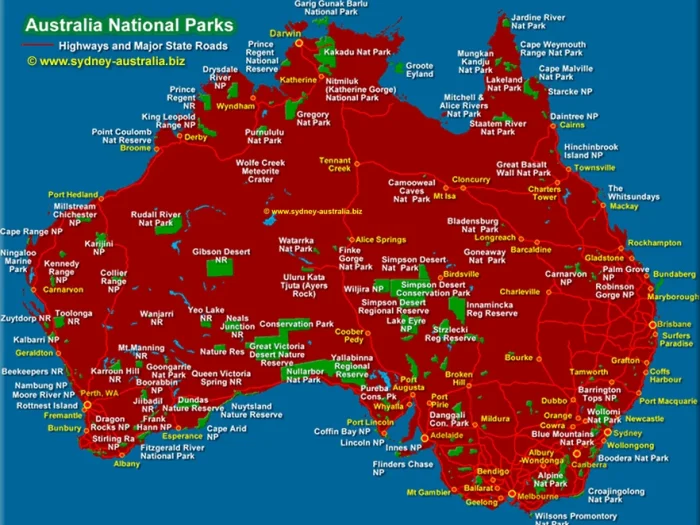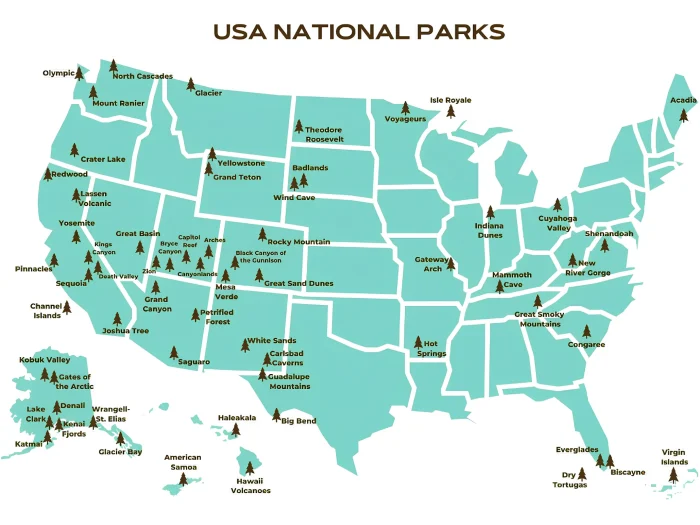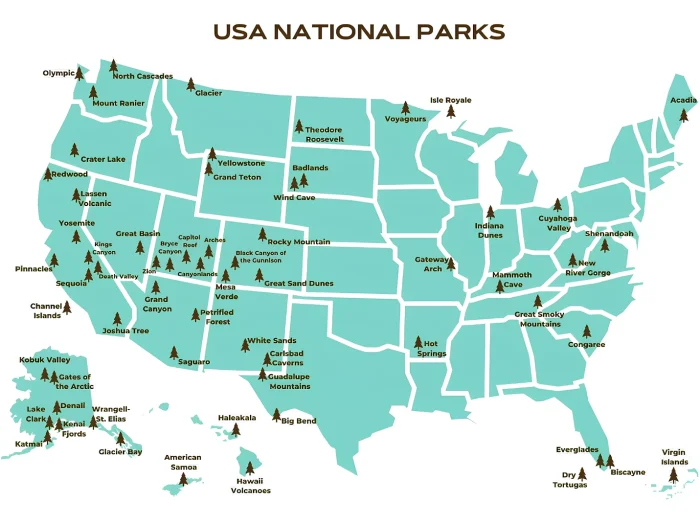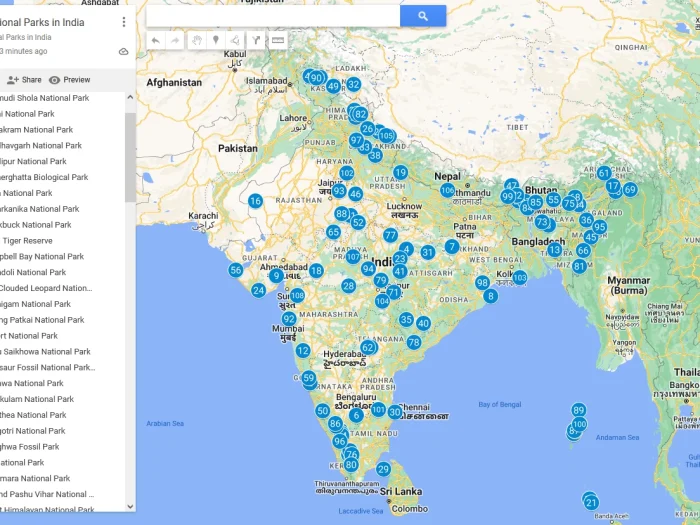List of National Parks in Arkansas
List of National Parks in Arkansas
Arkansas has 7 national parks:
- Arkansas Post National Memorial
- Buffalo National River
- Fort Smith National Historic Site
- Hot Springs National Park
- Little Rock Central High School National Historic Site
- Pea Ridge National Military Park
- President William Jefferson Clinton Birthplace Home National Historic Site
In this article I will write about these National Parks (infomation, things to do, weather). I also add Arkansas National Parks map at the end of the article.

1. Arkansas Post National Memorial
Location: Arkansas Post National Memorial is located in southeastern Arkansas, near the town of Gillett. It commemorates the site of Arkansas Post, which was the first European settlement in the lower Mississippi River Valley and served as a key strategic location during the colonial and territorial periods of American history.
Address: 1741 Old Post Rd, Gillett, AR 72055, USA
Official website: https://www.nps.gov/arpo
Phone: +1 870-548-2207
Closest Airport: The closest major airport to Arkansas Post National Memorial is Bill and Hillary Clinton National Airport (LIT) in Little Rock, Arkansas. It is located approximately 100 miles northwest of the memorial. From Little Rock, visitors can rent a car and drive southeast to reach Arkansas Post National Memorial.
Things to Do:
- Visitor Center: Start your visit at the visitor center, where you can learn about the history of Arkansas Post through exhibits, artifacts, and interpretive displays.
- Historical Site: Explore the remains of the original Arkansas Post settlement, including the reconstructed Arkansas Post fort and the museum, which houses artifacts related to the site’s history.
- Nature Trails: The memorial also offers nature trails that wind through the surrounding natural areas, providing opportunities for hiking, birdwatching, and wildlife viewing.
- Picnicking: Pack a picnic and enjoy lunch at one of the designated picnic areas within the memorial grounds.
- Fishing: The memorial is located along the Arkansas River, offering opportunities for fishing and boating. Visitors can try their luck fishing for catfish, bass, and other species in the river.
Weather: The weather at Arkansas Post National Memorial varies throughout the year:
- Summer: Summers in southeastern Arkansas are typically hot and humid, with average high temperatures in the 80s to 90s Fahrenheit (around 27-32°C). Be prepared for high humidity and occasional thunderstorms.
- Fall: Fall brings milder temperatures and lower humidity levels, making it a pleasant time to visit the memorial. Average high temperatures range from the 70s to 80s Fahrenheit (around 21-27°C).
- Winter: Winters are generally mild in this region, with average high temperatures in the 50s to 60s Fahrenheit (around 10-20°C). However, cold snaps and occasional freezing temperatures can occur, so visitors should be prepared for variable weather conditions.
- Spring: Spring is a transitional season, with gradually warming temperatures and blooming flowers. Average high temperatures range from the 60s to 70s Fahrenheit (around 15-25°C), but be prepared for variability in weather conditions.
2. Buffalo National River
Buffalo National River is located in northern Arkansas, United States. It flows through the rugged Ozark Mountains and is known for its scenic beauty, clear waters, and opportunities for outdoor recreation. The river stretches approximately 135 miles from its headwaters in the Boston Mountains to its confluence with the White River.
Official website: https://www.nps.gov/buff/index.htm
Phone: +1 870-439-2502
Closest Airport: The closest major airport to Buffalo National River is Northwest Arkansas National Airport (XNA) in Highfill, Arkansas. It is located approximately 90 miles northwest of the park. From the airport, visitors can rent a car and drive southeast to reach Buffalo National River.
Things to Do:
- Canoeing and Kayaking: One of the most popular activities at Buffalo National River is paddling. The river offers opportunities for both calm floats and challenging whitewater adventures, depending on the section you choose to explore.
- Hiking: The park features numerous hiking trails that wind through the scenic landscape, offering opportunities to explore waterfalls, overlooks, and historic sites. Popular trails include the Lost Valley Trail, Hemmed-In Hollow Trail, and Centerpoint Trail.
- Camping: Buffalo National River offers a variety of camping options, including primitive campsites along the river, developed campgrounds with amenities, and backcountry camping for more adventurous travelers.
- Fishing: Fishing is permitted in Buffalo National River, with opportunities to catch smallmouth bass, largemouth bass, trout, and other species. Anglers must have a valid Arkansas fishing license.
- Wildlife Viewing: The park is home to a diverse array of wildlife, including deer, elk, black bears, and numerous bird species. Wildlife enthusiasts will enjoy exploring the park’s forests, meadows, and riverbanks in search of animal sightings.
Weather: The weather at Buffalo National River varies throughout the year:
- Summer: Summers in northern Arkansas are typically hot and humid, with average high temperatures in the 80s to 90s Fahrenheit (around 27-32°C). Be prepared for occasional thunderstorms and high humidity.
- Fall: Fall brings milder temperatures and colorful foliage to the region, making it a popular time to visit the park. Average high temperatures range from the 60s to 70s Fahrenheit (around 15-25°C).
- Winter: Winters are generally mild, with average high temperatures in the 40s to 50s Fahrenheit (around 4-10°C). However, cold snaps and occasional snowfall can occur, especially in higher elevations.
- Spring: Spring is a transitional season, with gradually warming temperatures and blooming wildflowers. Average high temperatures range from the 50s to 70s Fahrenheit (around 10-25°C), but be prepared for variable weather conditions.
3. Fort Smith National Historic Site
Fort Smith National Historic Site is located in Fort Smith, Arkansas, United States. It preserves the historic site of the original Fort Smith, which played a significant role in the settlement of the American West and the enforcement of federal law in the late 19th and early 20th centuries.
Address: 301 Parker Ave, Fort Smith, AR 72901, United States
Official website: http://www.nps.gov/fosm/index.htm
Phone: +1 479-783-3961
Closest Airport: The closest major airport to Fort Smith National Historic Site is Fort Smith Regional Airport (FSM), located just a few miles southeast of downtown Fort Smith. It serves as the primary commercial airport for the region, providing domestic flights to several major cities.
Things to Do:
- Visitor Center: Start your visit at the visitor center, where you can learn about the history of Fort Smith and its significance in the development of the American West through exhibits, films, and ranger-led programs.
- Historic Structures: Explore the historic structures within the site, including the remains of the original fort, the courtroom of the federal courthouse, and the jail where infamous outlaws were held.
- Walking Tours: Take a self-guided walking tour of the site to explore its historic buildings, interpretive panels, and scenic views of the Arkansas River.
- Ranger Programs: Participate in ranger-led programs and guided tours to gain further insight into the history and significance of Fort Smith National Historic Site.
- Nearby Attractions: Fort Smith offers a variety of other attractions and activities, including parks, museums, and cultural events. Visitors can explore downtown Fort Smith, visit nearby parks and nature reserves, or take a scenic drive along the Arkansas River.
Weather: The weather at Fort Smith National Historic Site varies throughout the year:
- Summer: Summers in Fort Smith are typically hot and humid, with average high temperatures in the 80s to 90s Fahrenheit (around 27-32°C). Be prepared for high humidity and occasional thunderstorms.
- Fall: Fall brings milder temperatures and colorful foliage to the region, making it a pleasant time to visit the historic site. Average high temperatures range from the 60s to 70s Fahrenheit (around 15-25°C).
- Winter: Winters are generally mild, with average high temperatures in the 40s to 50s Fahrenheit (around 4-10°C). However, cold snaps and occasional snowfall can occur, especially in January and February.
- Spring: Spring is a transitional season, with gradually warming temperatures and blooming flowers. Average high temperatures range from the 50s to 70s Fahrenheit (around 10-25°C), but be prepared for variable weather conditions.
4. Hot Springs National Park
Hot Springs National Park is located in central Arkansas, United States, adjacent to the city of Hot Springs. The park is renowned for its thermal hot springs, which have attracted visitors for centuries due to their purported healing properties.
Address: Hot Springs, AR 71901, United States
Official website: https://www.nps.gov/hosp/index.htm
Phone: +1 501-620-6715
Closest Airport: The closest major airport to Hot Springs National Park is Bill and Hillary Clinton National Airport (LIT) in Little Rock, Arkansas. It is located approximately 60 miles northeast of Hot Springs. From the airport, visitors can rent a car and drive southwest to reach the park.
Things to Do:
- Bathing in Hot Springs: Visitors can experience the thermal hot springs by bathing in the historic bathhouses located within the park. Several bathhouses, including the Fordyce Bathhouse, have been restored and are open to the public for guided tours.
- Hiking: Hot Springs National Park offers a variety of hiking trails that wind through the scenic Ouachita Mountains and provide opportunities to explore the natural beauty of the area. Popular trails include the Hot Springs Mountain Trail, West Mountain Trail, and Gulpha Gorge Trail.
- Scenic Drives: The park features scenic drives, such as the Hot Springs Mountain Drive and West Mountain Drive, which offer panoramic views of the surrounding landscape and access to overlooks and historic sites.
- Picnicking: Several picnic areas within the park provide opportunities for visitors to enjoy meals amidst the natural beauty of Hot Springs National Park.
- Visitor Center: The park’s visitor center provides information about the park’s history, geology, and recreational opportunities. It also offers exhibits and ranger-led programs.
Weather: The weather at Hot Springs National Park varies throughout the year:
- Summer: Summers in central Arkansas are typically hot and humid, with average high temperatures in the 80s to 90s Fahrenheit (around 27-32°C). Be prepared for high humidity and occasional thunderstorms.
- Fall: Fall brings milder temperatures and colorful foliage to the region, making it a popular time to visit the park. Average high temperatures range from the 60s to 70s Fahrenheit (around 15-25°C).
- Winter: Winters are generally mild, with average high temperatures in the 40s to 50s Fahrenheit (around 4-10°C). However, cold snaps and occasional snowfall can occur, especially in January and February.
- Spring: Spring is a transitional season, with gradually warming temperatures and blooming flowers. Average high temperatures range from the 50s to 70s Fahrenheit (around 10-25°C), but be prepared for variable weather conditions.
5. Little Rock Central High School National Historic Site
Little Rock Central High School National Historic Site is located in Little Rock, Arkansas, United States. It commemorates the historic events surrounding the desegregation of Little Rock Central High School in 1957, a pivotal moment in the Civil Rights Movement.
Address: 2120 W Daisy L Gatson Bates Dr, Little Rock, AR 72202, United States
Official website: http://www.nps.gov/chsc/index.htm
Phone: +1 501-374-1957
Closest Airport: The closest major airport to Little Rock Central High School National Historic Site is Bill and Hillary Clinton National Airport (LIT) in Little Rock, Arkansas. It is located approximately 7 miles southwest of the historic site. From the airport, visitors can easily access the historic site by car or public transportation.
Things to Do:
- Visitor Center: Start your visit at the visitor center, which offers exhibits, films, and ranger-led programs that provide context and insight into the events of the Little Rock Nine and the desegregation crisis at Central High School.
- Historic Site: Tour the exterior of Little Rock Central High School, where visitors can view the iconic facade and gain a deeper understanding of the school’s significance in the struggle for civil rights.
- Ranger-Led Tours: The National Park Service offers ranger-led tours of the historic site, providing visitors with guided interpretation and storytelling about the events of 1957 and the ongoing fight for equality.
- Nearby Attractions: Little Rock offers a variety of other attractions and activities for visitors to explore, including the William J. Clinton Presidential Library, Riverfront Park, and the Historic Arkansas Museum.
Weather: The weather in Little Rock, Arkansas, varies throughout the year:
- Summer: Summers are typically hot and humid, with average high temperatures in the 80s to 90s Fahrenheit (around 27-32°C). Be prepared for high humidity and occasional thunderstorms.
- Fall: Fall brings milder temperatures and colorful foliage to the region, making it a pleasant time to visit the historic site. Average high temperatures range from the 60s to 70s Fahrenheit (around 15-25°C).
- Winter: Winters are generally mild, with average high temperatures in the 40s to 50s Fahrenheit (around 4-10°C). However, cold snaps and occasional snowfall can occur, especially in January and February.
- Spring: Spring is a transitional season, with gradually warming temperatures and blooming flowers. Average high temperatures range from the 50s to 70s Fahrenheit (around 10-25°C), but be prepared for variable weather conditions.
6. Pea Ridge National Military Park
Pea Ridge National Military Park is located in northwest Arkansas, near the town of Garfield. It preserves the site of the Battle of Pea Ridge, which took place during the American Civil War in March 1862. The park commemorates this significant Civil War battle and its impact on the region.
Address: 15930 National Park Dr, Garfield, AR 72732, United States
Official website: http://www.nps.gov/peri/index.htm
Phone: +1 479-451-8122
Closest Airport: The closest major airport to Pea Ridge National Military Park is Northwest Arkansas National Airport (XNA) in Highfill, Arkansas. It is located approximately 30 miles northeast of the park. From the airport, visitors can rent a car and drive south to reach Pea Ridge National Military Park.
Things to Do:
- Visitor Center: Start your visit at the visitor center, where you can learn about the Battle of Pea Ridge and the park’s significance through exhibits, artifacts, and interpretive displays.
- Auto Tour: The park offers a self-guided auto tour that takes visitors through key areas of the battlefield, with interpretive signs providing information about the battle’s events and participants.
- Hiking Trails: Pea Ridge National Military Park features several hiking trails that wind through the battlefield and surrounding landscape, offering opportunities for exploration and reflection. Popular trails include the Elkhorn Trail and the Van Winkle Hollow Trail.
- Ranger Programs: Ranger-led programs and guided tours are available seasonally, providing visitors with additional insight into the history and significance of the battle.
- Picnicking: The park offers picnic areas where visitors can enjoy lunch amidst the natural beauty of Pea Ridge National Military Park.
Weather: The weather at Pea Ridge National Military Park varies throughout the year:
- Summer: Summers in northwest Arkansas are typically hot and humid, with average high temperatures in the 80s to 90s Fahrenheit (around 27-32°C). Be prepared for high humidity and occasional thunderstorms.
- Fall: Fall brings milder temperatures and colorful foliage to the region, making it a popular time to visit the park. Average high temperatures range from the 60s to 70s Fahrenheit (around 15-25°C).
- Winter: Winters are generally mild, with average high temperatures in the 40s to 50s Fahrenheit (around 4-10°C). However, cold snaps and occasional snowfall can occur, especially in January and February.
- Spring: Spring is a transitional season, with gradually warming temperatures and blooming flowers. Average high temperatures range from the 50s to 70s Fahrenheit (around 10-25°C), but be prepared for variable weather conditions.
7. President William Jefferson Clinton Birthplace Home National Historic Site
President William Jefferson Clinton Birthplace Home National Historic Site is located in Hope, Arkansas, United States. It preserves the childhood home of President Bill Clinton, the 42nd President of the United States, and commemorates his early years growing up in Hope.
Address: 117 S Hervey St, Hope, AR 71801, United States
Official website: https://www.nps.gov/wicl/index.htm
Phone: +1 870-777-4455
Closest Airport: The closest major airport to President William Jefferson Clinton Birthplace Home National Historic Site is Texarkana Regional Airport (TXK) in Texarkana, Arkansas. It is located approximately 30 miles southwest of Hope. From the airport, visitors can rent a car and drive east to reach the historic site.
Things to Do:
- Visitor Center: Start your visit at the visitor center, where you can learn about President Clinton’s early life and career through exhibits, artifacts, and multimedia presentations.
- Tour the Birthplace Home: Take a guided tour of the modest home where President Clinton was born and spent the first few years of his life. The home has been restored to reflect the time period when the Clinton family lived there.
- Explore the Grounds: Stroll through the surrounding grounds of the historic site, which include interpretive panels providing additional information about President Clinton’s upbringing in Hope.
- Learn about Hope: Take the opportunity to explore the town of Hope itself, which played a significant role in shaping President Clinton’s character and values. Visit local attractions, shops, and restaurants to get a sense of the community where he grew up.
Weather: The weather in Hope, Arkansas, varies throughout the year:
- Summer: Summers are typically hot and humid, with average high temperatures in the 80s to 90s Fahrenheit (around 27-32°C). Be prepared for high humidity and occasional thunderstorms.
- Fall: Fall brings milder temperatures and colorful foliage to the region, making it a pleasant time to visit the historic site. Average high temperatures range from the 60s to 70s Fahrenheit (around 15-25°C).
- Winter: Winters are generally mild, with average high temperatures in the 40s to 50s Fahrenheit (around 4-10°C). However, cold snaps and occasional snowfall can occur, especially in January and February.
- Spring: Spring is a transitional season, with gradually warming temperatures and blooming flowers. Average high temperatures range from the 50s to 70s Fahrenheit (around 10-25°C), but be prepared for variable weather conditions.
Arkansas National Parks map
Tag: List of National Parks in Arkansas




